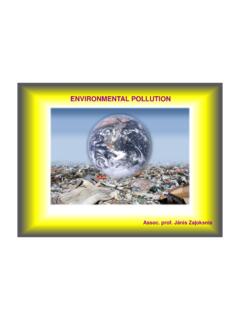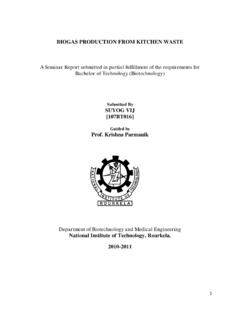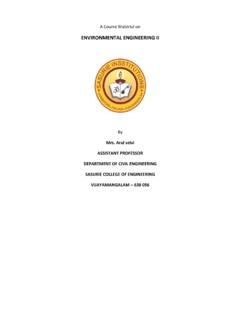Transcription of SOLID WASTE MANAGEMENT - LU
1 1 SOLID WASTE MANAGEMENT Dr. J nis Za oksnis 2 2 Municipal SOLID WASTE , commonly known as trash or garbage (US), refuse or rubbish (UK) is a WASTE type consisting of everyday items we consume and discard. It predominantly includes food wastes, yard wastes, containers and product packaging, and other miscellaneous inorganic wastes from residential, commercial, institutional, and industrial sources. Examples of organic wastes are newspapers, clothing, food scrapes, boxes, disposable tableware, office and classroom paper, furniture, wood pallets, rubber tires, and canteen or cafeteria wastes. Municipal SOLID WASTE does not include industrial wastes, agricultural wastes, and sewage sludge.
2 The collection is performed by the municipality within a given area. They are in either SOLID or semisolid form. SOLID WASTE 3 SOLID WASTE , Hawaii, US 4 4 Types of WASTE : Biodegradable WASTE : food and kitchen WASTE , green WASTE , paper (can be recycled); Recyclable material: paper, glass bottles, cans, metals, certain plastics, etc.; Inert WASTE : construction and demolition WASTE , dirt, rocks, debris; Composite wastes: WASTE closing, Tetra Packs, WASTE plastics such as toys; Domestic hazardous WASTE & toxic WASTE : medication or drugs, E- WASTE , paints, chemicals, light bulbs or fluorescent tubes, spray cans, fertilizers and pesticides and their containers, batteries, shoe polish materials.
3 , etc. SOLID WASTE 5 5 WASTE is SOLID substances generated as a result of human activities, and, being no longer of value for the respective economic, physiological or technological process, are removed from it. SOLID WASTE in a broader sense is understood as any household, industrial and agricultural materials that have been used up. Since such WASTE accumulates in the territories managed by municipalities responsible for its removal and storage, it is termed municipal SOLID WASTE . Municipal SOLID WASTE include also: ash generated in thermal or electric power plants sludge from wastewater treatment plants animal farm WASTE gangue rocks from mineral extraction SOLID WASTE Sometimes these types of WASTE require separate sectors in landfills.
4 6 SOLID WASTE 7 BIODEGRADABLE WASTE Biodegradable WASTE is a type of WASTE , typically originating from plant or animal sources, which may be degraded by other living organisms. WASTE that cannot be broken down by other living organisms are called non-biodegradable. Biodegradable WASTE can be commonly found in municipal SOLID WASTE as green WASTE , food WASTE , paper WASTE , and biodegradable plastics. Other biodegradable wastes include human WASTE , manure, sewage, sloughterhouse WASTE . In the absence of oxygen much of this WASTE will decay to methane by anaerobic digestion. 8 BIODEGRADABLE WASTE Biodegradable WASTE can often be used for composting or must be a resource for heat, electricity and fuel in future.
5 This produces additional biogas and still delivers the compost for the soil. The oldest of the companies own lorries has achieved kilometres driven with biogas from household WASTE in the last 15 years. 9 biogas biogas typically refers to a gas produced by the biological breakdown of organic matter in the absence of oxygen. Organic WASTE such as dead plant and animal material, animal dung, and kitchen WASTE can be converted into a gaseous fuel called biogas . biogas originates from biogenic material and is a type of biofuel. biogas comprises primarily methane (CH4) and carbon dioxide (CO2) and may have small amounts of hydrogen sulphide (H2S) and moisture.
6 The gases methane, hydrogen, and carbon monoxide can be combusted or oxidized with oxygen. This energy release allows biogas to be used as a fuel. biogas can be used as a fuel in any country for any heating purpose, such as cooking. It can also be used in anaerobic digesters where it is typically used in a gas engine to convert the energy in the gas into electricity and heat. biogas can be compressed, much like natural gas, and used to power motor vehicles. In the UK, for example, biogas is estimated to have the potential to replace around 17% of vehicle fuel. biogas is a renewable fuel, so it qualifies for renewable energy subsidies in some parts of the world.
7 biogas can also be cleaned and upgraded to natural gas standards when it becomes biomethane. 10 biogas production in rural Germany. Pipes carrying biogas , natural gas and condensate. 11 GREEN WASTE Green WASTE is biodegradable WASTE that can be composed of garden or park waste1, such as grass or flower cuttings and hedge (dz v oga) trimmings, as well as domestic and commercial food WASTE . The differentiation green identifies it as high in nitrogen, as opposed to brown WASTE , which is primarily carbonaceous. Green WASTE is often collected in municipal collection schemes or through private WASTE MANAGEMENT contractor businesses.
8 12 FOOD WASTE Apples (Granny Smith variety) are among the most wasted foods in the UK - 190,000 tonnes per year are thrown away. Food WASTE or food loss is food that is discarded or lost uneaten. As of 2011, billion tons of food, about one third of the global food production, are lost or wasted annually. Loss and wastage occurs on all steps in the food supply chain. In low-income countries most loss occurs during production, while in developed countries much food about 100 kilograms per person and year is wasted at the consumption stage. Limiting food wastage has seen the adoption of former WWI and II slogans. 13 FOOD LOSS AND WASTE Food loss and WASTE per person and year Total, kg At the production and retail stages, kg By consumers, kg Europe 280 190 90 North America and Oceania 295 185 110 Industrialized Asia 240 160 80 Subsaharan Africa 160 155 5 North Africa, West and Central Asia 215 180 35 South and Southeast Asia 125 110 15 Latin America 225 200 25 Food loss measures the decrease in edible food mass (excluding inedible parts and seed), that is, loss at the production, post-harvest and processing stages.
9 This definition of loss includes biomass originally meant for human consumption but eventually used for some other purpose, such as fuel or animal feed. Food WASTE are food losses occurring during the retail and final consumption stage due to the behaviour of retailers and consumers that is, the throwing away of food. 14 CONSTRUCTION WASTE Construction WASTE consists of unwanted material produced directly or incidentally by the construction or industries. This includes building materials such as insulation, nails, electrical wiring, as well as WASTE originating from site preparation such as dredging (bagar tie) materials, tree stumps, and rubble.
10 Construction WASTE may contain lead, asbestos, or other hazardous substances. Much building WASTE is made up of materials such as bricks, concrete and wood damaged or unused for various reasons during construction. Observational research has shown that this can be as high as 10 to 15 % of the materials that go into a building, a much higher percentage than the % usually assumed by quantity surveyors and the construction industry. Since considerable variability exists between construction sites, there is much opportunity for reducing this WASTE . 15 CONSTRUCTION WASTE Certain components of construction WASTE such as plasterboards are hazardous once landfilled.










